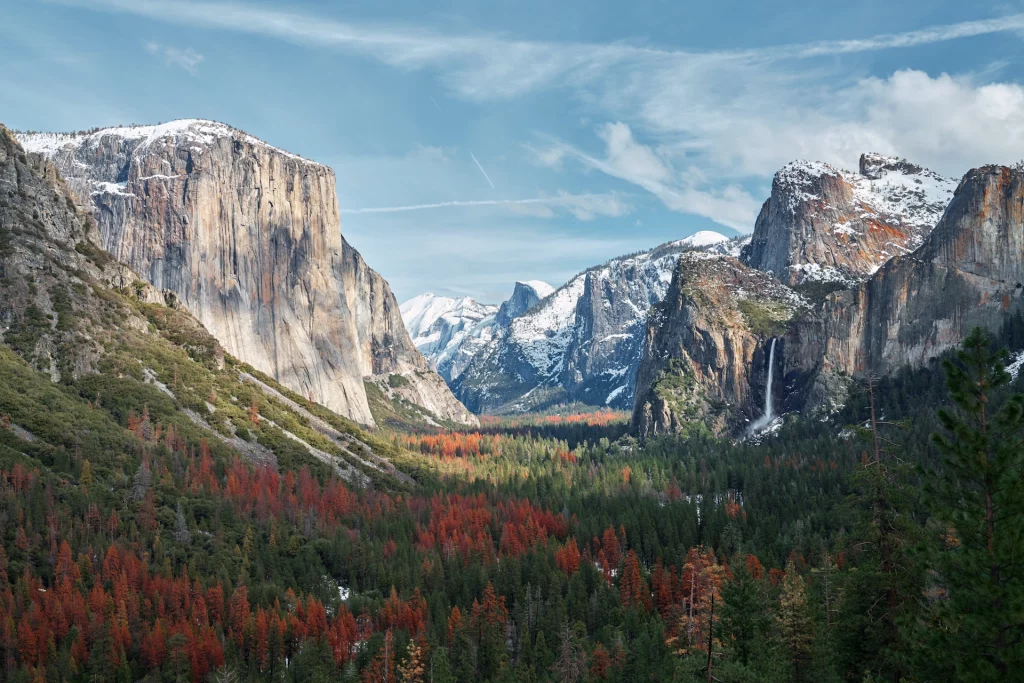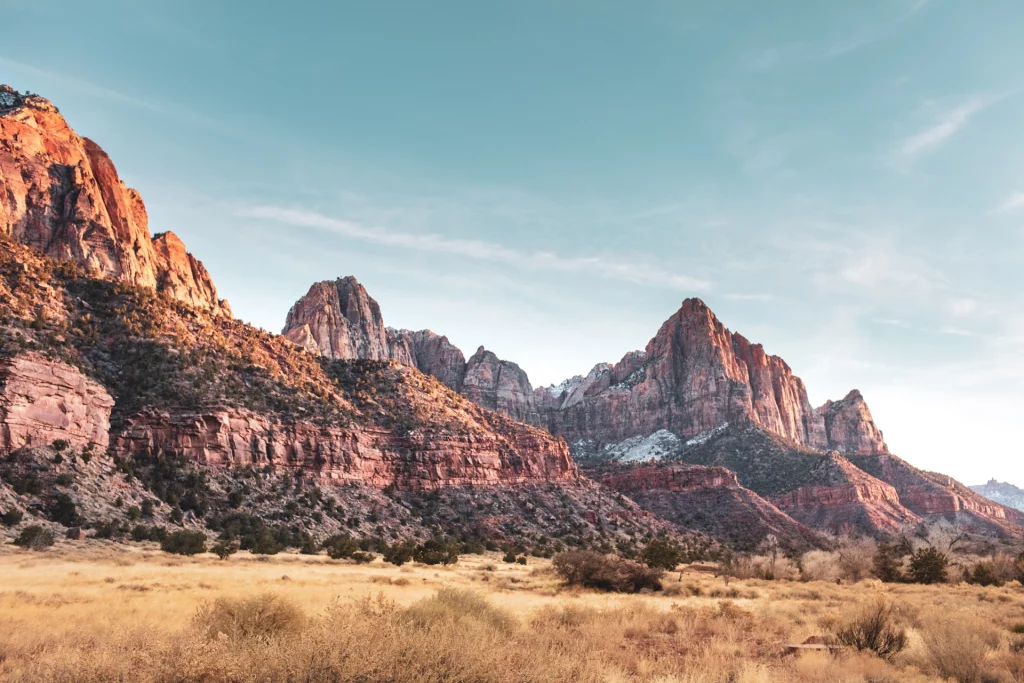Embarking on a mountain hiking adventure is about embracing the wild, natural landscapes while challenging one’s physical and mental boundaries. The United States is home to a vast array of mountain ranges, each with unique trails that beckon both the novice and seasoned alpinists. This article unfolds a curated list of ten unmissable mountain hiking destinations scattered across the U.S. Each destination holds a distinct allure, offering a blend of awe-inspiring vistas, thrilling ascents, and enriching experiences that linger long after the journey. Whether you’re yearning for a tranquil retreat amidst serene peaks or seeking the adrenaline rush of scaling towering heights, this guide unfolds the top locales where every footstep on the trail promises a narrative of discovery and self-fulfillment.
Rocky Mountain National Park, Colorado
Overview of the Park:
Nestled in the heart of Colorado, the Rocky Mountain National Park is a haven for mountain enthusiasts. Boasting over 300 miles of hiking trails, this park presents a diverse terrain ranging from gentle meadows to rugged mountainous landscapes. The elevations here span 7,500 to 14,259 feet, offering a playground for both novices and experienced hikers.
Highlighted Trails:
One of the most celebrated trails is the Emerald Lake Trail, a moderately challenging hike leading to a pristine alpine lake. For a taste of the high alpine environment, the Trail Ridge Road offers an exhilarating trek with panoramic vistas of the surrounding peaks.
Practical Information:
The park operates year-round, though the prime hiking season is from late May to early October. It’s advisable to check trail conditions and weather forecasts before embarking on a hike. Don’t miss the chance to camp under the stars, with several campgrounds available within the park.
Yosemite National Park, California
Overview of the Park:
A realm of grandiose landscapes, Yosemite National Park encapsulates the essence of mountain wilderness. With its iconic granite cliffs, lush meadows, and ancient sequoias, Yosemite is a mosaic of natural wonders. The park’s trails offer varying levels of difficulty, catering to a broad spectrum of hikers.
Highlighted Trails:
The Mist Trail is a quintessential Yosemite hike, leading adventurers past Vernal and Nevada Falls, with the option to extend the hike to Half Dome, a Yosemite hallmark. For a less strenuous venture, the Tuolumne Meadows provides a peaceful retreat amidst wildflower fields and gentle streams.
Practical Information:
The park is accessible year-round, though some trails may be closed during the winter months due to snow. Advanced reservations are recommended for camping, and obtaining a wilderness permit is essential for overnight hikes. Be sure to check the park’s website for current conditions and any alerts before planning your visit.

Mount Rainier National Park, Washington
Overview of the Park:
An emblem of the Pacific Northwest, Mount Rainier National Park harbors a majestic, snow-capped volcano that towers at an elevation of 14,411 feet. The park’s diverse ecosystems encompass lush forests, subalpine meadows, and glacial landscapes, offering a multifaceted hiking experience.
Highlighted Trails:
The Skyline Trail circles the Paradise area, providing a closer glimpse of Mount Rainier’s glacier-clad flanks along with a myriad of wildflowers in summer. For a more demanding trek, the Camp Muir route challenges hikers with its rocky terrain and snowfields, leading to a high camp used by many aspiring summiters.
Practical Information:
The hiking season primarily spans from July to September, with many trails being snow-covered outside this period. It’s advisable to check trail conditions on the park’s website and consider registering at a ranger station before heading out on more challenging routes.
Grand Teton National Park, Wyoming
Overview of the Park:
Home to the iconic Teton Range, Grand Teton National Park in Wyoming unfolds a landscape of jagged peaks juxtaposed against serene lakes. The park’s trails traverse through alpine meadows, dense forests, and along pristine lakeshores, offering varying levels of difficulty for hikers.
Highlighted Trails:
The Cascade Canyon Trail is renowned for its scenic splendor, leading hikers into the heart of the Tetons. For those seeking a serene lakeside hike, the Jenny Lake Loop offers a tranquil sojourn with captivating views of the surrounding peaks.
Practical Information:
The ideal hiking season is from late May to September. Backcountry camping requires a permit, and it’s highly recommended to make campground reservations in advance during peak season. For up-to-date trail conditions and other essential information, visiting the park’s visitor centers or its website is advisable.
Zion National Park, Utah
Overview of the Park:
With its towering red rock cliffs and a myriad of scenic trails, Zion National Park in Utah is a haven for hiking aficionados. The park’s diverse topography encompasses narrow slot canyons, vast mesas, and serene rivers, presenting a rich tapestry of hiking experiences.
Highlighted Trails:
One of the iconic trails is the Angels Landing, a strenuous route that rewards the brave with panoramic vistas atop a sandstone fin. For a less challenging yet equally rewarding hike, the Riverside Walk offers a leisurely stroll along the Virgin River.
Practical Information:
The park is accessible year-round, though spring and fall witness the most favorable weather. Some trails might require permits, and it’s advisable to check the park’s website for current conditions and necessary reservations. The shuttle service within the park eases transportation, especially during the peak season.

Acadia National Park, Maine
Overview of the Park:
Situated on Maine’s Mount Desert Island, Acadia National Park is a blend of rocky coastline and wooded peaks. Its diverse trails weave through dense forests, alongside tranquil ponds, and atop rugged cliffs, offering a serene yet stimulating hiking experience.
Highlighted Trails:
The Jordan Pond Path provides a peaceful excursion around a pristine pond, while the Precipice Trail challenges the daring with a steep ascent to stunning views atop Champlain Mountain.
Practical Information:
The prime hiking season extends from spring to fall, with some trails closed during winter due to icy conditions. It’s recommended to check the park’s website for trail closures and advisories. Additionally, securing campground reservations in advance is wise, especially during the summer months.
Mount Hood, Oregon
Overview of Mount Hood:
Towering over northern Oregon, Mount Hood is a stratovolcano cloaked in glaciers and alpine meadows. This iconic peak offers a variety of trails that cater to hikers of all skill levels, surrounded by a breathtaking landscape marked by wildflowers, waterfalls, and pristine lakes.
Highlighted Trails:
The Timberline Trail circumnavigates the mountain, offering a challenging multi-day hiking experience with awe-inspiring views. For a less strenuous day hike, the Trillium Lake Loop provides a tranquil setting with a perfect backdrop of Mount Hood’s reflection on the lake.
Practical Information:
The optimal hiking season is from late spring to early fall. It’s advisable to check trail conditions and weather forecasts before embarking on hikes, especially the more demanding ones. Camping is available in designated campgrounds, with reservations recommended during the peak season.
The Adirondacks, New York
Overview of The Adirondacks:
Encompassing a vast natural wilderness, The Adirondacks in New York State is a sprawling mountainous region with over 2,000 miles of hiking trails. The area offers a rich tapestry of terrains, from gentle wooded paths to challenging summit hikes.
Highlighted Trails:
The High Peaks Wilderness area is a popular destination for ambitious hikers aiming to conquer some of the tallest summits in the state. For a family-friendly hike, the Mount Jo Trail provides a moderate challenge with rewarding views over Heart Lake.
Practical Information:
The hiking season here extends from late spring to early fall, though some trails are accessible year-round. It’s essential to check current trail conditions and adhere to the Leave No Trace principles to preserve the natural beauty of the region.
Mount Mitchell, North Carolina
Overview of Mount Mitchell:
Standing as the highest peak east of the Mississippi, Mount Mitchell in North Carolina towers at an elevation of 6,684 feet. The mountain is nestled within the Pisgah National Forest, offering a network of trails amidst a landscape of lush forests and sweeping vistas.
Highlighted Trails:
The Mount Mitchell Summit Trail leads hikers to the peak, offering a panoramic view of the surrounding Appalachian Highlands. For a longer trek, the Black Mountain Crest Trail provides a challenging yet rewarding hike across multiple peaks.
Practical Information:
The hiking season here spans from late spring to early fall, with cooler temperatures at higher elevations even in summer. It’s advisable to check the weather forecast and trail conditions on the park’s website before planning your hike. Camping options are available in the nearby national forest.
Conclusion
The poetic allure of mountain landscapes is timeless, with every peak offering a distinct narrative. The U.S. is a goldmine for hiking enthusiasts and alpinists, holding a myriad of trails that promise both adventure and introspection. The ten destinations highlighted in this guide are gateways to experiencing the diverse topographical tapestry the country offers. Each trail discussed not only challenges one’s physical prowess but also unveils a realm of natural beauty and tranquility. So, as you plan your next hiking expedition, let the trails in these destinations lead you to experiences that resonate with adventure, self-discovery, and the simple joy of being amidst nature’s grandeur.
